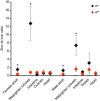Biogenesis of zinc storage granules in Drosophila melanogaster
- PMID: 29367274
- PMCID: PMC5897703
- DOI: 10.1242/jeb.168419
Biogenesis of zinc storage granules in Drosophila melanogaster
Abstract
Membrane transporters and sequestration mechanisms concentrate metal ions differentially into discrete subcellular microenvironments for use in protein cofactors, signalling, storage or excretion. Here we identify zinc storage granules as the insect's major zinc reservoir in principal Malpighian tubule epithelial cells of Drosophila melanogaster The concerted action of Adaptor Protein-3, Rab32, HOPS and BLOC complexes as well as of the white-scarlet (ABCG2-like) and ZnT35C (ZnT2/ZnT3/ZnT8-like) transporters is required for zinc storage granule biogenesis. Due to lysosome-related organelle defects caused by mutations in the homologous human genes, patients with Hermansky-Pudlak syndrome may lack zinc granules in beta pancreatic cells, intestinal paneth cells and presynaptic vesicles of hippocampal mossy fibers.
Keywords: AP-3 complex; Eye color mutants; ICP-OES; Malpighian tubules; Synchrotron; Zincosomes.
© 2018. Published by The Company of Biologists Ltd.
Conflict of interest statement
Competing interestsThe authors declare no competing or financial interests.
Figures








Similar articles
-
Functional studies of Drosophila zinc transporters reveal the mechanism for zinc excretion in Malpighian tubules.BMC Biol. 2017 Feb 14;15(1):12. doi: 10.1186/s12915-017-0355-9. BMC Biol. 2017. PMID: 28196538 Free PMC article.
-
Tryptophan regulates Drosophila zinc stores.Proc Natl Acad Sci U S A. 2022 Apr 19;119(16):e2117807119. doi: 10.1073/pnas.2117807119. Epub 2022 Apr 11. Proc Natl Acad Sci U S A. 2022. PMID: 35412912 Free PMC article.
-
The expression of Catsup in the hindgut is essential for zinc homeostasis in Drosophila melanogaster.Insect Mol Biol. 2024 Dec;33(6):601-612. doi: 10.1111/imb.12916. Epub 2024 Apr 25. Insect Mol Biol. 2024. PMID: 38664880
-
Molecular basis for epithelial morphogenesis and ion transport in the Malpighian tubule.Curr Opin Insect Sci. 2021 Oct;47:7-11. doi: 10.1016/j.cois.2021.02.001. Epub 2021 Feb 10. Curr Opin Insect Sci. 2021. PMID: 33581351 Free PMC article. Review.
-
The road to lysosome-related organelles: Insights from Hermansky-Pudlak syndrome and other rare diseases.Traffic. 2019 Jun;20(6):404-435. doi: 10.1111/tra.12646. Traffic. 2019. PMID: 30945407 Free PMC article. Review.
Cited by
-
An ABCG Transporter Functions in Rab Localization and Lysosome-Related Organelle Biogenesis in Caenorhabditis elegans.Genetics. 2020 Feb;214(2):419-445. doi: 10.1534/genetics.119.302900. Epub 2019 Dec 17. Genetics. 2020. PMID: 31848222 Free PMC article.
-
Identification and characterization of a heme exporter from the MRP family in Drosophila melanogaster.BMC Biol. 2022 Jun 2;20(1):126. doi: 10.1186/s12915-022-01332-0. BMC Biol. 2022. PMID: 35655259 Free PMC article.
-
Lysosome-related organelles promote stress and immune responses in C. elegans.Commun Biol. 2023 Sep 13;6(1):936. doi: 10.1038/s42003-023-05246-7. Commun Biol. 2023. PMID: 37704756 Free PMC article.
-
Inflammatory-Metal Profile as a Hallmark for COVID-19 Severity During Pregnancy.Front Cell Dev Biol. 2022 Aug 9;10:935363. doi: 10.3389/fcell.2022.935363. eCollection 2022. Front Cell Dev Biol. 2022. PMID: 36016660 Free PMC article.
-
Dietary Zinc Limitation Dictates Lifespan and Reproduction Trade-Offs of Drosophila Mothers.Aging Cell. 2025 May;24(5):e14498. doi: 10.1111/acel.14498. Epub 2025 Jan 31. Aging Cell. 2025. PMID: 39891318 Free PMC article.
References
-
- Ammann S., Schulz A., Krageloh-Mann I., Dieckmann N. M., Niethammer K., Fuchs S., Eckl K. M., Plank R., Werner R., Altmuller J. et al. (2016). Mutations in AP3D1 associated with immunodeficiency and seizures define a new type of Hermansky-Pudlak syndrome. Blood 127, 997-1006. 10.1182/blood-2015-09-671636 - DOI - PMC - PubMed
-
- Assoum M., Philippe C., Isidor B., Perrin L., Makrythanasis P., Sondheimer N., Paris C., Douglas J., Lesca G., Antonarakis S. et al. (2016). Autosomal-recessive mutations in AP3B2, adaptor-related protein complex 3 β2 subunit, cause an early-onset epileptic encephalopathy with optic atrophy. Am. J. Hum. Genet. 99, 1368-1376. 10.1016/j.ajhg.2016.10.009 - DOI - PMC - PubMed
Publication types
MeSH terms
Substances
Grants and funding
LinkOut - more resources
Full Text Sources
Other Literature Sources
Molecular Biology Databases

